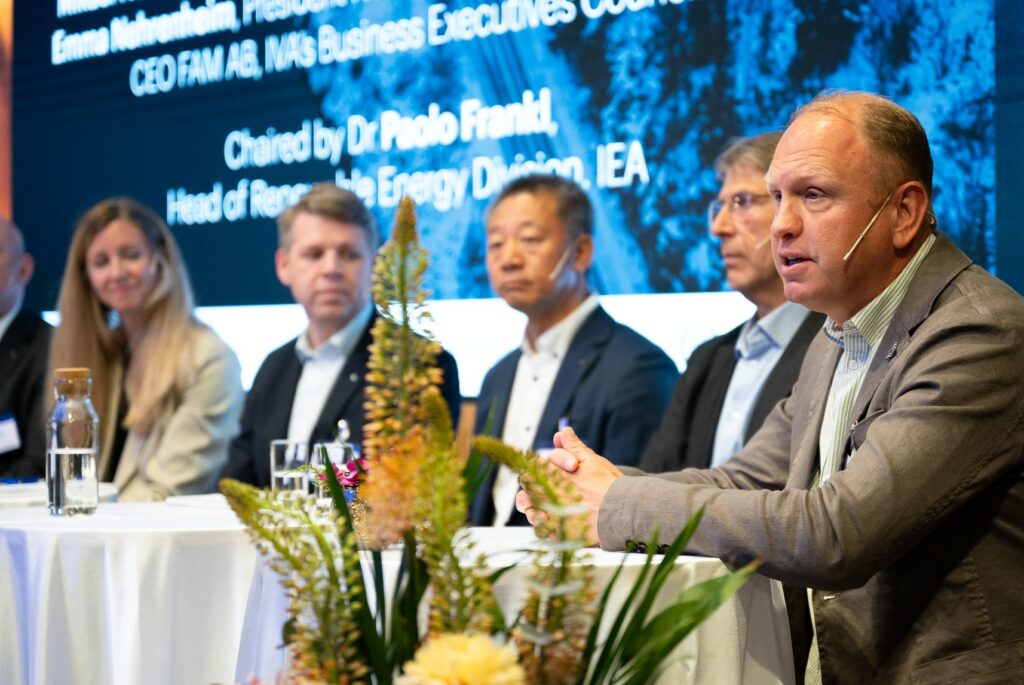Emma Nehrenheim, Northvolt Materials, Mikael Nordlander, Vattenfall, Martin Pei, SSAB, Jan Moström, LKAB, and Henrik Henriksson, H2 Green Steel. Photo: Erik Cronberg, IVA.
The Royal Swedish Academy of Engineering Sciences (IVA) organized the high-level conference “Climate Urgency and the Nordic Response” on June 12 in Stockholm, in collaboration with Mistra Electrification and Mistra Carbon Exit.
Marcus Wallenberg, Chair of IVA, opened the conference by saying that the outcome of the election to the European Parliament made it not clear to him in what direction politics will guide society.
“If I sound concerned, I am. We need transition and gain speed in the transition. The factor of time is so important, we don’t talk enough about that. If you are going to make big investments, you need to know that conditions remain stable, stability is crucial to invest,” said Marcus Wallenberg.
Romina Pourmokhtari, Swedish Minister for Climate and the Environment, said that the EU ETS serves as a powerful tool for transition.
“It is a great incentive. The EU ETS provides predictability and therefore stability. The Swedish Government believes ETS is the future, therefore we are looking at how to develop it,” said Romina Pourmokhtari.
Dr Paolo Frankl, head of renewable energy in the IEA and who chaired three panels in the conference, first presented a statement of Dr Fatih Birol, the executive director of the IEA, which encouraged the Nordics to be a forerunner in the energy transition.
Lars Zetterberg, Senior Researcher, IVL Swedish Environmental Research Institute, said that the price of emission allowances is a game-changer for the industry. When the Fit-for-55 climate package was presented the allowance price passed 100 euros per ton for the first time.
“When the price reaches 70–100 euros per ton, it becomes profitable to transform, since fossil-free steel and cement start to be competitive with traditional steel and cement. After 2030 there will be a shortage of emission allowances, which will drive up prices even further. Thus, the pressure on the basic industries and refineries to transform will be significant,” said Lars Zetterberg.
Ida Karlsson, Chalmers University of Technology, who recently obtained her PhD on decarbonization of buildings and infrastructure within the Mistra Carbon Exit programme, talked about that the industrial green transition is happening now.
“When Mistra Carbon Exit started in 2017, Hybrit was talking about being fossil free in 2045. Now, they say 2030”, said Ida Karlsson.
Henrik Henriksson, CEO, H2 Green Steel, stressed the importance that Brussels holds on to the ambitious climate policy.
“Maybe, in the future, steel production will be located where there is clean and low cost power production and a robust grid. So, support to industries should not primarily be based on where they have been located historically,” said Henrik Henriksson.
Jan Moström, CEO, LKAB, stressed the need for cost efficient electricity and hydrogen.
“I expect the same development in electrolysers as we have seen in solar panels. So far, hydrogen production has been on a very small scale,” said Jan Moström.
Mikael Nordlander, Director Industry Decarbonization, Vattenfall, mentioned Sweden’s advantages, where hydro power plays an important part.
“Sweden already has a decarbonized system and a surplus of electricity; therefore, Sweden is an excellent place for the transition. Other countries need to develop solutions faster than us,” said Mikael Nordlander.
Filip Johnsson, Professor, Chalmers University of Technology, stressed that Sweden’s potential for renewable electricity production is very good compared to other countries in Europe.
“Sweden stands out positively because our electricity production is already nearly fossil-free and because we have a net export of electricity on an annual basis, which almost no other countries have. We have a responsibility to utilize our good conditions in the Nordics as a means to be a forerunner in the transition”, said Filip Johnsson.
Dr Dallas Burtraw, Darius Gaskins Senior Fellow, Resources for the Future, Washington, DC, gave insights from the USA about the Inflation Reduction Act (IRA).
“Republican states to are supportive of IRA. So, it will remain largely intact, no matter who wins the upcoming presidential election,” said Dallas Burtraw.
Dr Paolo Frankl, Head of Renewable Energy Division, IEA, summarized the conference by saying the discussion is not about if the transition will happen, it is about what role Europe will take in the transition.
“There is no time to lose if Europe is to become the engine of clean energy, we need to act now. And the Nordics could be a model for Europe as a whole,” concluded Paolo Frankl.
The conference was recorded and can be seen below.

